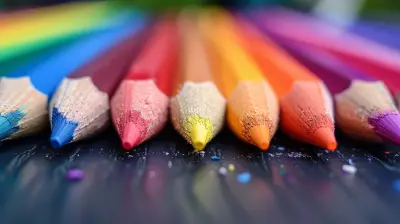Understanding Gender Differences in Communication Styles
28 June 2025
Have you ever walked away from a conversation thinking, "Did we just speak two different languages?" You're not alone. While men and women obviously speak the same language, their communication styles can differ in ways that sometimes make it seem like they’re from different planets. These subtle (and sometimes not-so-subtle) differences can cause confusion, frustration, and missed opportunities—especially in educational, workplace, and interpersonal settings.
In this article, we’re going to dig deep into the fascinating world of gender-based communication styles. Not just to compare and contrast, but to understand the why behind these differences and how they impact everything from classroom interactions to career advancement and even day-to-day relationships.
Why Talk About Gender and Communication?
You might be wondering, “Why does this even matter?” Here's the thing: communication is at the heart of learning, collaboration, and moving forward in any part of life. Whether you're a student, a teacher, a manager, or just someone trying to build stronger relationships, understanding how gender can shape communication helps you connect more effectively.And no, this isn’t about putting people into boxes or saying one method is better than the other. It’s about awareness. Once you’re aware of the patterns, you can work with them—not against them.
The Roots of Communication Differences
Let’s start from the ground up.1. Nature vs. Nurture
There’s always been a debate: are communication styles determined by biology or by society? The answer? A bit of both.Scientists have found that hormones like testosterone and estrogen can influence how the brain processes emotion and language. So yes, biology plays a role. But from a young age, boys and girls are also socialized differently. Think about it: girls are often encouraged to be expressive and nurturing, while boys are taught to be assertive and self-reliant. These early lessons shape how we talk, how we listen, and even what we talk about.
2. Social Conditioning and Expectations
Society often expects men to be direct, confident, even dominant in conversation. Women, on the other hand, are often expected to be more empathetic, collaborative, and polite. While not everyone fits that mold, these expectations still echo through classrooms, boardrooms, and kitchen tables.
How Men and Women Tend to Communicate Differently
Let’s zoom in on some of the biggest differences in how men and women typically communicate. Again, these are general patterns—not hard-and-fast rules. People are individuals, and there's always variation within each gender.1. Language Use
- Men tend to use communication to establish status or solve problems. They're more likely to give direct commands and are less likely to seek input if they already believe they know the answer.- Women often use communication to build connections and foster relationships. They’re more likely to ask questions, use collaborative language (“Let’s do this together”), and soften statements (“I think we might”).
Ever notice how men might say, “Move that chair,” while women might say, “Would you mind moving that chair?” Both are asking for the same thing, but with different tones.
2. Listening Styles
- Men may listen quietly or even interrupt to offer solutions—because to them, fixing the issue is a form of caring.- Women are more likely to use active listening. They nod, make eye contact, and use phrases like “I see” or “That makes sense,” to show they’re fully engaged.
It’s not that one listens better than the other—it’s that the purpose of listening can be different. For men, it’s about resolution. For women, it’s about empathy.
3. Nonverbal Communication
Body language matters—a lot.- Women typically use more expressive facial gestures, nod more in agreement, and maintain better eye contact. This signals openness and attentiveness.
- Men may use fewer gestures, stand or sit in ways that signal dominance (think: legs apart, arms stretched out), and maintain less eye contact.
These cues can shape how others perceive confidence, engagement, and approachability—often unfairly.
The Impact of These Differences in Real Life
So, how do these different styles show up in real environments? Let’s take a look.A. In Education
Ever noticed how boys and girls participate differently in class? Boys may raise their hands more frequently and speak more assertively, even if they’re unsure. Girls, on the other hand, may hesitate to speak unless they’re certain they’re right.Teachers, often unconsciously, may reward this assertiveness and see it as confidence—leaving quieter students overlooked. Understanding these dynamics can help educators create balanced, inclusive classrooms where every voice counts.
B. In the Workplace
Communication style can affect promotions, team dynamics, and leadership opportunities. A man’s directness might be seen as assertive, while a woman’s collaborative tone might be mistaken for indecisiveness.It’s a double-bind. If women communicate too directly, they risk being labeled aggressive. If they’re too nurturing, they might not be taken seriously. The key for workplaces? Recognize that different styles bring value and create space for both.
C. In Personal Relationships
This is where it gets personal, right?How many arguments start with, “You’re not listening to me!” but what’s really going on is differing expectations?
- One person wants to vent.
- The other rushes in with solutions.
- Both feel unheard.
Knowing that men may communicate to resolve, while women may communicate to relate, can help couples navigate misunderstandings. Sometimes, all it takes is saying, “Do you want advice, or do you just need to talk?”
Avoiding Stereotypes While Embracing Awareness
Let’s be clear: not every man is stoic, and not every woman is expressive. We’re all on a spectrum, and our individual personalities play a huge role in how we communicate.Think of these gendered patterns as guidelines, not gospel.
The danger lies in assuming too much. If you expect every man to avoid emotion or every woman to be empathetic, you're not seeing the person—you’re seeing a stereotype.
So, awareness is powerful, but it must be used mindfully.
How to Bridge the Gap
So, what can you do now that you're aware?1. Practice Active Listening
No matter your gender, learning to really listen—with curiosity rather than judgment—goes a long way in smoothing communication bumps.2. Adapt Your Style
Being flexible doesn’t mean being fake. It means recognizing how others communicate and adjusting your approach. It shows respect and increases clarity.3. Ask Instead of Assuming
If you’re confused about someone’s tone, intent, or approach—ask! Simple questions like “Can you clarify what you meant?” or “How can I support you?” can prevent a lot of conflict.4. Encourage Diverse Voices
In classrooms, meetings, and group settings, invite contributions from everyone. Make space for different communication styles so no one gets drowned out.The Role of Education in Shaping Communication Awareness
Education is a powerful tool—not just for facts and figures, but for building empathy and understanding. When schools and universities actively address communication differences, they equip students with life skills that go way beyond the classroom.From group projects to public speaking to online discussions, educators can:
- Highlight diverse voices
- Teach inclusive communication practices
- Encourage self-awareness and emotional intelligence
It’s not just about “talking better”—it’s about connecting more genuinely.
Final Thoughts: It’s Not a Competition—It’s a Conversation
At the end of the day, understanding gender differences in communication styles isn’t about deciding who’s right or wrong. It’s about meeting in the middle. It’s realizing that how we say things matters just as much as what we say. And if we give each other a little grace, a little space, and a little curiosity, we can communicate in ways that are not just effective—but meaningful.So next time you find yourself puzzled by someone’s communication style, pause. Ask yourself: Are they really wrong, or just… different?
Chances are, it’s the latter.
all images in this post were generated using AI tools
Category:
Communication SkillsAuthor:

Olivia Chapman
Discussion
rate this article
1 comments
Destiny McGarvey
Embrace diversity in communication for deeper connections!
July 11, 2025 at 12:51 PM

Olivia Chapman
Absolutely! Embracing diverse communication styles fosters understanding and strengthens connections across gender differences.


